- Joined
- Feb 2, 2011
- Messages
- 2,339
THE ANCIENTS
ARMIES AND ENEMIES OF THE NEW KINGDOM EGYPTIANS
NUBIAN AND LIBYAN MERCENARIES
During the 20th Dynasty Egyptian power declined, and Egypt itself was beset with Libyan incursions and attempted invasions by the sea peoples.

The Libyans were originally composed of two peoples namely the Tehenu and the Temehu. These were later joined by tribes called the Kehek and Meshwesh, the latter being the most notable of all the Libyan tribes.
These peoples never did well against the Egyptians due mainly to their lack of chariots, and were no match for the Egyptians at this time.
The first Libyan War in 1193 BC, Pharaoh Rameses III of the 20th Dynasty fought a mixed army of Libyans and Sea Peoples, which were led by King Themer. The invaders were beaten back with over 12,000 killed and 1,000 taken prisoner.
Libyans wore animal hide cloaks and had dyed ostrich feathers in their hair.
Many Libyans who raided Egypt during the reigns of Merenptah and Ramesses III were captured and impressed as auxiliary troops in the Egyptian army. Ramesses III’s battle scenes illustrate many Libyans armed with bows, as well as long slashing swords traded from the sea peoples.
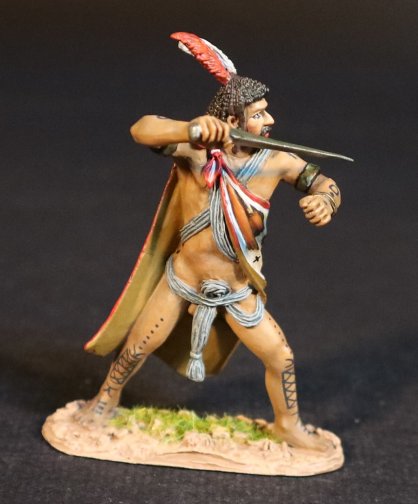
NKE-24
THE ANCIENTS,
NEW KINGDOM EGYPTIANS,
THE BATTLE OF KADESH 1274BC,
LIBYAN MERCENARY
ARMIES AND ENEMIES OF GREECE AND MACEDONIA
THE ACHAEMENID PERSIAN ARMY
KARDAKE INFANTRY
Kardakes translated means “foreign mercenaries”
The Kardakes are a part of the Persian army that also appears towards the later empire, it is uncertain what they really were. Some say that they were mercenaries, others that they were influenced by the
Greek Hoplites and that we should assume that they were a Persian attempt to reform the army in a Greek way.

The Kardakes are described by historians as "Hoplites", Slingers and "Peltasts". This may illustrate that Kardakes most likely were not a specific troop type, like a heavy infantryman or a skirmisher but rather a specific group which supplied several kinds of soldiers.
This means that the Kardakes would have been equipped differently. At the battle of Issus Arrian calls them Hoplites, and Kallisthenes as Peltasts.
KARDAKE LIGHT INFANTRY
There has always been some debate over the armament and how the Kardakes were employed as a fighting force. As previously mentioned several historians have described them as peltasts.
Modern scholars seem to deduce from this that there was an attempt to produce a native Persian close fighting infantry to support the mercenary Greek hoplite, and Kardakes Hoplites, against the Macedonian phalanx.
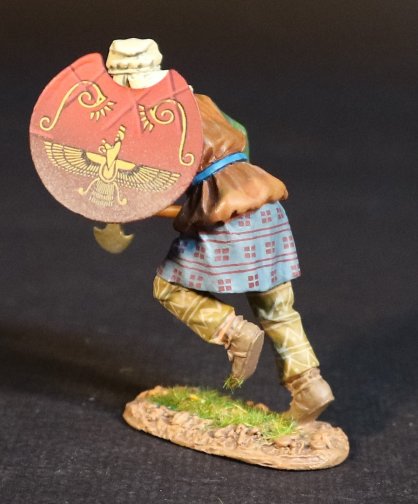
AP-26A
ARMIES AND ENEMIES OF ANCIENT GREECE AND MACEDONIA,
THE ACHAEMENID PERSIAN ARMY,
KARDAKE LIGHT INFANTRY
Xenophon describes the Kardakes as carrying two javelins, and using a Kopis or a Sagaris ( the bronze pick-like Saka battleaxe, which was adopted by the Persians) and a wicker shield. It is also confirmed that many would also have used bows.
The Alexander sarcophagus shows Persian infantry not only carrying Hoplite shields, but many with crescent shaped shields similar to the Greek peltai.
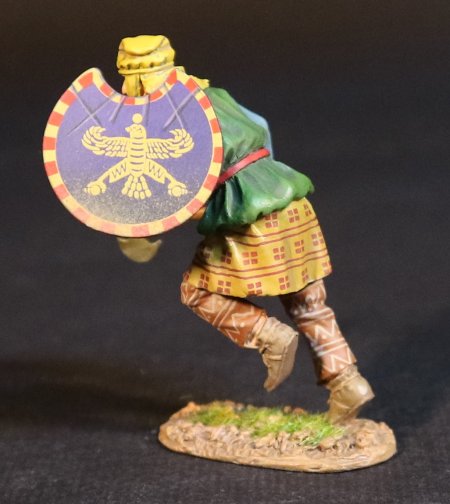
AP-26B
ARMIES AND ENEMIES OF ANCIENT GREECE AND MACEDONIA,
THE ACHAEMENID PERSIAN ARMY,
KARDAKE LIGHT INFANTRY
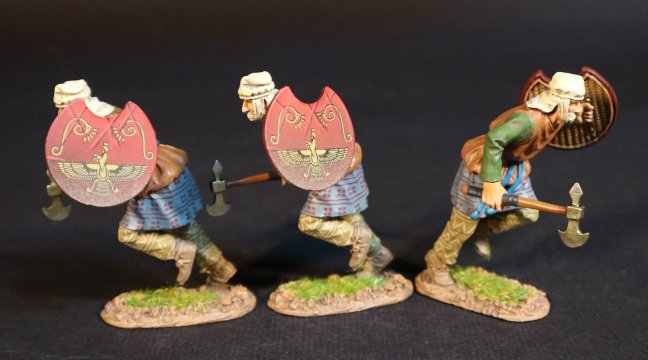
AP-26AN
ARMIES AND ENEMIES OF ANCIENT GREECE AND MACEDONIA,
THE ACHAEMENID PERSIAN ARMY,
KARDAKE LIGHT INFANTRY
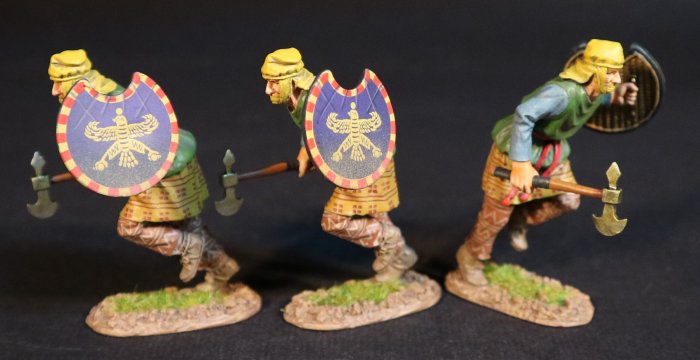
AP-26BN
ARMIES AND ENEMIES OF ANCIENT GREECE AND MACEDONIA,
THE ACHAEMENID PERSIAN ARMY,
KARDAKE LIGHT INFANTRY
ARMIES AND ENEMIES OF ANCIENT ROME
THE CARTHAGINIANS
CELTIBERIAN SCUTARIUS
Although initially the Carthaginian army was composed only of Citizens of Phoenician origin, it saw increased recruitment of contingents of mercenaries and allies a necessity in order to realize the policy of imperial expansion.
This use of mercenaries saved the metropolitan population from heavy casualties that were not easily replaceable, and it also reflected the Carthaginian concept of war, which was considered simply as an extension of business.
With the enlargement of Punic economic interests the army became more exclusively mercenary and progressively came to include almost all the peoples of the central and western Mediterranean area.
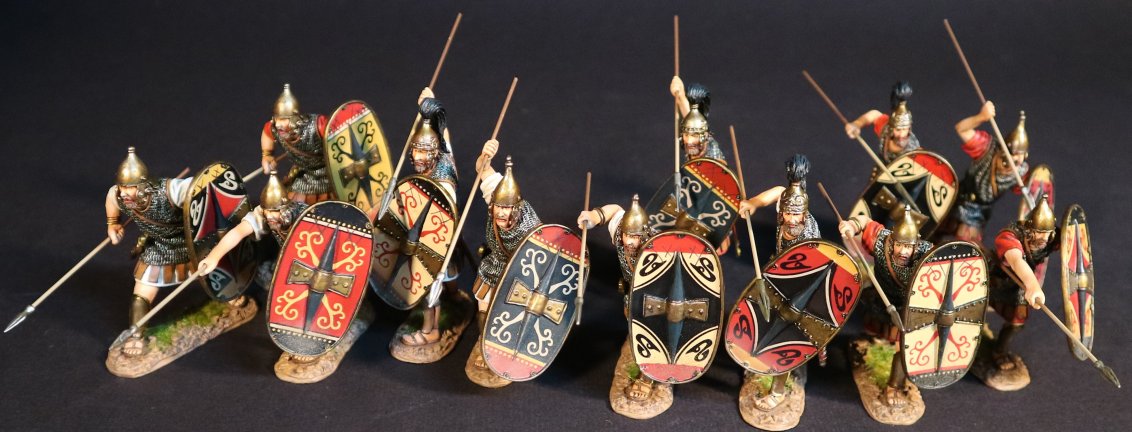
The success of Carthage in bringing most of central and southern Iberia under its control was a crucial element in their continued ability to pursue the war against Rome.
Iberian troops probably fell into two rough classifications, the Scutarii and the Caetratii.
These types basically defined the type of shield, with the Scutum being a large flat oval shield with a wooden spine and metal boss.
The Caetra was a flat, smaller round shield with a circular metal boss.
Both troop types were armed with a dagger and sword, as well as spears for hand to hand fighting and for throwing.
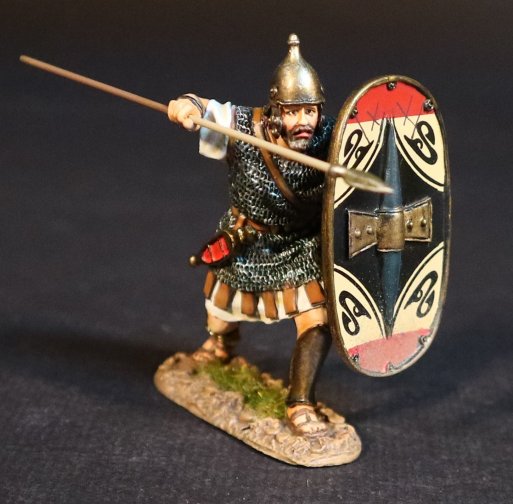
CTIB-07A
ARMIES AND ENEMIES OF ANCIENT ROME,
THE CARTHAGINIANS,
CELTIBARIAN SCUTARII
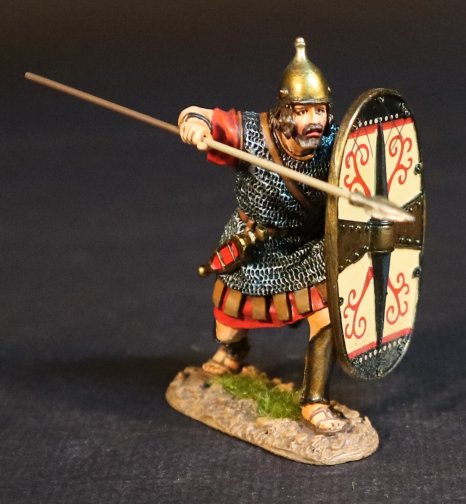
CTIB-07B
ARMIES AND ENEMIES OF ANCIENT ROME,
THE CARTHAGINIANS,
CELTIBARIAN SCUTARII
The Scutarius were well armoured heavy infantry, and the Celtibarians were mainly from the north, and were heavily influenced by their Gallic neighbours. Those who fought with Hannibal would have been mercenaries, and in organization and military effectiveness would have been much the same as the Gauls. They were known to be fierce, independent and dangerous.
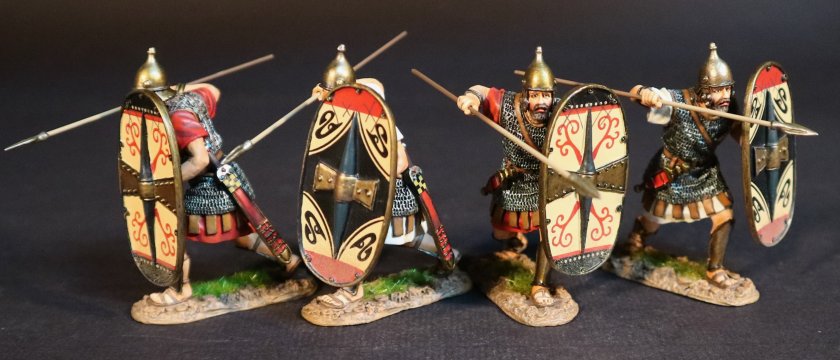
CTIB-07N
ARMIES AND ENEMIES OF ANCIENT ROME,
THE CARTHAGINIANS,
CELTIBARIAN SCUTARIUS
ANCIENT GERMANS
Following two decades of Roman occupation, Germania Magna erupted into revolt in AD 9, resulting in the stunning loss of three Roman legions to an alliance of Germanic nations at Teutoburg. The Battle of the Teutoburg Forest, described as the Varian Disaster by Roman historians, took place in the Teutoburg Forest in 9 CE, when an alliance of Germanic tribes ambushed and decisively destroyed three Roman legions and their auxiliaries, led by Publius Quinctilius Varus.
The alliance was led by Arminius, a Germanic officer of Varus' auxilia. Arminius had acquired Roman citizenship and had received a Roman military education, which enabled him to deceive the Roman commander methodically and anticipate the Roman army's tactical responses.
Despite several successful campaigns and raids by the Romans in the years after the battle, they never again attempted to conquer the Germanic territories east of the Rhine river. The victory of the Germanic tribes against Rome's legions in the Teutoburg Forest would have far-reaching effects on the subsequent history of both the ancient Germanic peoples and the Roman Empire. Contemporary and modern historians have generally regarded Arminius' victory over Varus as "Rome's greatest defeat", one of the most decisive battles recorded in military history, and as "a turning-point in world history".
The Germanic warrior was a well trained, battle-hardened, combat ready and motivated fighter, who excelled in irregular warfare, ambushes, raids and petty warfare. In an ambush the lightly armed Germanic fighter could decisively defeat a heavily equipped legionary by using surprise and the terrain to his advantage.
These warriors were perfectly equipped for the Germanic landscape of open fields, forests and swamps. The weapons which were used included the long lance or Framea, which could be swung, thrust or thrown at an opponent.
Hair was grown long and often tied up in a figure of eight or “Suebian” knot.
In a set-piece battle the German could stand up to the Roman Legionary discipline and formations for a while, but in close quarters combat the advantage eventually shifted to the legionary.
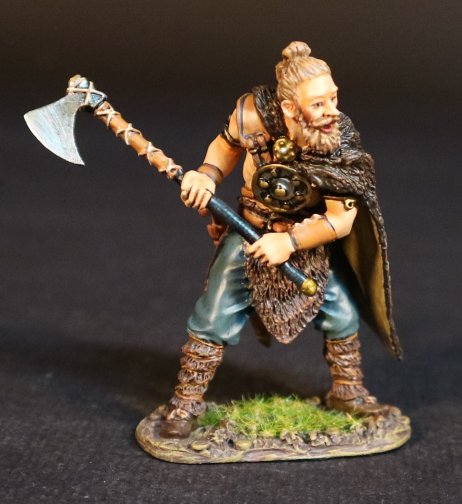
AG-18
ARMIES AND ENEMIES OF ANCIENT ROME,
GERMANIC WARRIOR
Expected in mid-June. Place those pre-orders early!
ARMIES AND ENEMIES OF THE NEW KINGDOM EGYPTIANS
NUBIAN AND LIBYAN MERCENARIES
During the 20th Dynasty Egyptian power declined, and Egypt itself was beset with Libyan incursions and attempted invasions by the sea peoples.

The Libyans were originally composed of two peoples namely the Tehenu and the Temehu. These were later joined by tribes called the Kehek and Meshwesh, the latter being the most notable of all the Libyan tribes.
These peoples never did well against the Egyptians due mainly to their lack of chariots, and were no match for the Egyptians at this time.
The first Libyan War in 1193 BC, Pharaoh Rameses III of the 20th Dynasty fought a mixed army of Libyans and Sea Peoples, which were led by King Themer. The invaders were beaten back with over 12,000 killed and 1,000 taken prisoner.
Libyans wore animal hide cloaks and had dyed ostrich feathers in their hair.
Many Libyans who raided Egypt during the reigns of Merenptah and Ramesses III were captured and impressed as auxiliary troops in the Egyptian army. Ramesses III’s battle scenes illustrate many Libyans armed with bows, as well as long slashing swords traded from the sea peoples.

NKE-24
THE ANCIENTS,
NEW KINGDOM EGYPTIANS,
THE BATTLE OF KADESH 1274BC,
LIBYAN MERCENARY
ARMIES AND ENEMIES OF GREECE AND MACEDONIA
THE ACHAEMENID PERSIAN ARMY
KARDAKE INFANTRY
Kardakes translated means “foreign mercenaries”
The Kardakes are a part of the Persian army that also appears towards the later empire, it is uncertain what they really were. Some say that they were mercenaries, others that they were influenced by the
Greek Hoplites and that we should assume that they were a Persian attempt to reform the army in a Greek way.

The Kardakes are described by historians as "Hoplites", Slingers and "Peltasts". This may illustrate that Kardakes most likely were not a specific troop type, like a heavy infantryman or a skirmisher but rather a specific group which supplied several kinds of soldiers.
This means that the Kardakes would have been equipped differently. At the battle of Issus Arrian calls them Hoplites, and Kallisthenes as Peltasts.
KARDAKE LIGHT INFANTRY
There has always been some debate over the armament and how the Kardakes were employed as a fighting force. As previously mentioned several historians have described them as peltasts.
Modern scholars seem to deduce from this that there was an attempt to produce a native Persian close fighting infantry to support the mercenary Greek hoplite, and Kardakes Hoplites, against the Macedonian phalanx.

AP-26A
ARMIES AND ENEMIES OF ANCIENT GREECE AND MACEDONIA,
THE ACHAEMENID PERSIAN ARMY,
KARDAKE LIGHT INFANTRY
Xenophon describes the Kardakes as carrying two javelins, and using a Kopis or a Sagaris ( the bronze pick-like Saka battleaxe, which was adopted by the Persians) and a wicker shield. It is also confirmed that many would also have used bows.
The Alexander sarcophagus shows Persian infantry not only carrying Hoplite shields, but many with crescent shaped shields similar to the Greek peltai.

AP-26B
ARMIES AND ENEMIES OF ANCIENT GREECE AND MACEDONIA,
THE ACHAEMENID PERSIAN ARMY,
KARDAKE LIGHT INFANTRY

AP-26AN
ARMIES AND ENEMIES OF ANCIENT GREECE AND MACEDONIA,
THE ACHAEMENID PERSIAN ARMY,
KARDAKE LIGHT INFANTRY

AP-26BN
ARMIES AND ENEMIES OF ANCIENT GREECE AND MACEDONIA,
THE ACHAEMENID PERSIAN ARMY,
KARDAKE LIGHT INFANTRY
ARMIES AND ENEMIES OF ANCIENT ROME
THE CARTHAGINIANS
CELTIBERIAN SCUTARIUS
Although initially the Carthaginian army was composed only of Citizens of Phoenician origin, it saw increased recruitment of contingents of mercenaries and allies a necessity in order to realize the policy of imperial expansion.
This use of mercenaries saved the metropolitan population from heavy casualties that were not easily replaceable, and it also reflected the Carthaginian concept of war, which was considered simply as an extension of business.
With the enlargement of Punic economic interests the army became more exclusively mercenary and progressively came to include almost all the peoples of the central and western Mediterranean area.

The success of Carthage in bringing most of central and southern Iberia under its control was a crucial element in their continued ability to pursue the war against Rome.
Iberian troops probably fell into two rough classifications, the Scutarii and the Caetratii.
These types basically defined the type of shield, with the Scutum being a large flat oval shield with a wooden spine and metal boss.
The Caetra was a flat, smaller round shield with a circular metal boss.
Both troop types were armed with a dagger and sword, as well as spears for hand to hand fighting and for throwing.

CTIB-07A
ARMIES AND ENEMIES OF ANCIENT ROME,
THE CARTHAGINIANS,
CELTIBARIAN SCUTARII

CTIB-07B
ARMIES AND ENEMIES OF ANCIENT ROME,
THE CARTHAGINIANS,
CELTIBARIAN SCUTARII
The Scutarius were well armoured heavy infantry, and the Celtibarians were mainly from the north, and were heavily influenced by their Gallic neighbours. Those who fought with Hannibal would have been mercenaries, and in organization and military effectiveness would have been much the same as the Gauls. They were known to be fierce, independent and dangerous.

CTIB-07N
ARMIES AND ENEMIES OF ANCIENT ROME,
THE CARTHAGINIANS,
CELTIBARIAN SCUTARIUS
ANCIENT GERMANS
Following two decades of Roman occupation, Germania Magna erupted into revolt in AD 9, resulting in the stunning loss of three Roman legions to an alliance of Germanic nations at Teutoburg. The Battle of the Teutoburg Forest, described as the Varian Disaster by Roman historians, took place in the Teutoburg Forest in 9 CE, when an alliance of Germanic tribes ambushed and decisively destroyed three Roman legions and their auxiliaries, led by Publius Quinctilius Varus.
The alliance was led by Arminius, a Germanic officer of Varus' auxilia. Arminius had acquired Roman citizenship and had received a Roman military education, which enabled him to deceive the Roman commander methodically and anticipate the Roman army's tactical responses.
Despite several successful campaigns and raids by the Romans in the years after the battle, they never again attempted to conquer the Germanic territories east of the Rhine river. The victory of the Germanic tribes against Rome's legions in the Teutoburg Forest would have far-reaching effects on the subsequent history of both the ancient Germanic peoples and the Roman Empire. Contemporary and modern historians have generally regarded Arminius' victory over Varus as "Rome's greatest defeat", one of the most decisive battles recorded in military history, and as "a turning-point in world history".
The Germanic warrior was a well trained, battle-hardened, combat ready and motivated fighter, who excelled in irregular warfare, ambushes, raids and petty warfare. In an ambush the lightly armed Germanic fighter could decisively defeat a heavily equipped legionary by using surprise and the terrain to his advantage.
These warriors were perfectly equipped for the Germanic landscape of open fields, forests and swamps. The weapons which were used included the long lance or Framea, which could be swung, thrust or thrown at an opponent.
Hair was grown long and often tied up in a figure of eight or “Suebian” knot.
In a set-piece battle the German could stand up to the Roman Legionary discipline and formations for a while, but in close quarters combat the advantage eventually shifted to the legionary.

AG-18
ARMIES AND ENEMIES OF ANCIENT ROME,
GERMANIC WARRIOR
Expected in mid-June. Place those pre-orders early!

